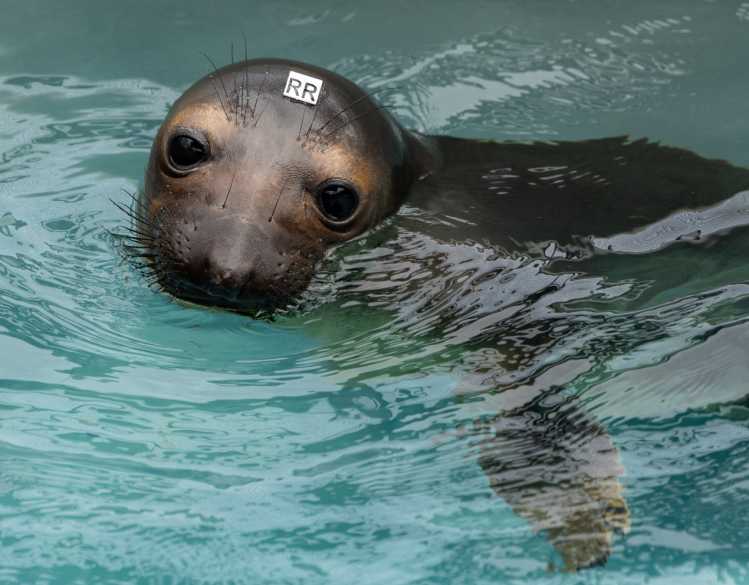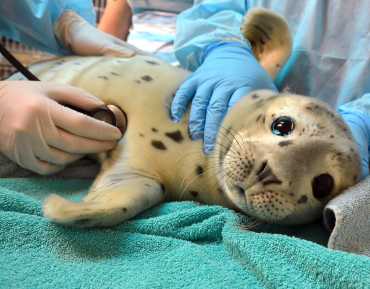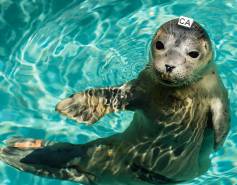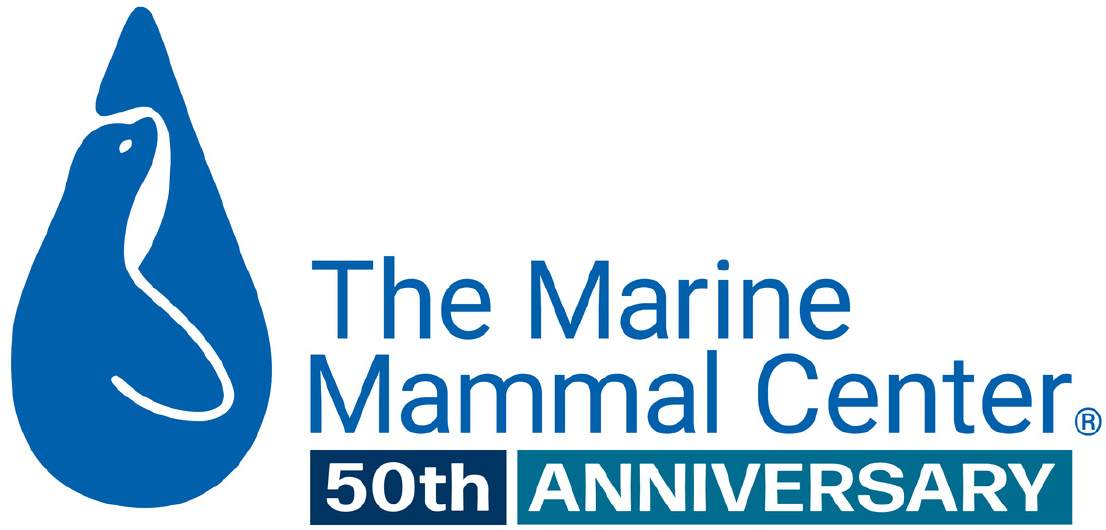
How Our Patients are Named and Identified
Each year, The Marine Mammal Center responds to up to 1,800 marine mammals that may be sick, injured, orphaned, or entangled in fishing gear or ocean trash. At our state-of-the-art hospital facilities, we provide expert medical care with the goal of returning patients back to their ocean home.
From individual names to specialized tags, learn how our experts identify and keep track of the seals, sea lions and sea otters in our care. Plus, find out how you can help the next animal in need when you adopt a past patient today.
How our patients get their names
Every animal at our hospital is assigned their own unique ID number that our experts use to track medical records in our database. But at the world’s largest marine mammal hospital where we can have hundreds of patients onsite at a time, staff and volunteers referring to animals solely by their ID numbers could get confusing. To make it easier to talk about our patients and better connect with their conservation stories, they also receive individual names.
In California, our marine mammal patients are named by our dedicated volunteers and caring people like you. After our trained responders rescue an animal, they typically ask for name suggestions from people on the beach who watched the rescue. And if they are still on the beach, the honor of choosing a name usually goes to the person who called our hotline to report the animal.
To avoid confusion, we don’t use the same name twice in a decade for each species. The Center has rescued more than 27,000 animals, so we have to be very creative!

Sometimes, patients are also given names that reflect their rescue story. California sea lion Pinger, for example, was rescued using a specialized “pinging” dart that we designed for high-risk disentanglements. Our trained responders launched the dart that sedates the sea lion while acoustic “pings” from the dart help responders track the animal until it can be safely netted from the water.

When a Hawaiian monk seal is admitted to Ke Kai Ola, our hospital on Hawai‘i Island dedicated to saving this endangered species, the naming process can vary depending on which island the seal was rescued on. The tradition of naming is culturally significant in Hawai‘i, and we honor the land and people by reflecting the traditions of each island.
Hawaiian monk seal patient names are typically chosen by a kupuna, a highly respected elder within the Hawaiian community. When a monk seal from the Northwestern Hawaiian Islands is rescued, our cultural advisor visits Ke Kai Ola to observe and learn about the animal. She uses her cultural knowledge to choose a name that best reflects the seal’s personality and Hawaiian spirit. These names are often an inoa pō, a Hawaiian tradition in which the name is received in a dream.

The naming process varies more for monk seals rescued on the Main Hawaiian Islands. Some islands follow similar naming practices to the Northwestern Hawaiian Islands, some have local community groups or schools select the names, and some choose not to name the seals (these patients are referred to by their unique identification numbers provided by NOAA).
Hat and flipper tags help identify our patients
Similar to a human hospital, our veterinary experts provide personalized care for our marine mammal patients based on their unique medical and health needs. Along with our patients’ fishy meals, specific medications must be given to specific animals as part of their treatment plan.
In a single pen at our hospital, there can be five or six seemingly identical seals resting on the pen floor or swimming in the pool. So how do our animal care staff and volunteers know which patient gets which medications?

At our hospital, biodegradable hat tags are placed on top of many of our patients’ heads with animal-safe glue. These temporary tags are etched with a unique letter or number combination, which is then logged in the patient’s medical record.
The prominent placement of these tags allows our experts to quickly identify animals and administer the right nutrition and medications. It’s important for our patients that our staff and volunteers spend as little time in the pens as possible to reduce the animals’ stress and their risk of becoming accustomed to humans.
All of our patients also receive brightly colored flipper tags with identification numbers. Unlike hat tags that eventually fall off, flipper tags are permanent and allow us to track individuals if they are resighted again in the wild throughout their lives.
When we see a marine mammal with a flipper tag and match its ID number with a previous patient in our database, our experts can gain important insights that help improve the care we provide and our long-term impact on advancing ocean health. Flipper tags also ensure that if a patient ever needs rescue a second time, we have a full health record to help inform the animal’s care.

Adopt-a-Seal® to help a patient in need
Did you know it’s only because of support from people like you that sick, injured, orphaned and entangled marine mammals can receive expert care? When you symbolically adopt a past patient, you’ll give current and future patients a second chance at life.
Adopt-a-Seal® collections include digital downloads that arrive instantly and physical certificates or gift packages that arrive in the mail.
Yes, I want to save a life!

Yes, I want to save a life!
You’ll be giving sick and injured animals the best possible care at the Center’s state-of-the-art hospital. With your gift today, you are giving a patient a second chance at life in the wild.
See Our Latest News
{"image":"\/Animals\/Patients\/Harbor seals\/2020\/cropped-images\/hs-barnwood-by-bill-hunnewell-c-the-marine-mammal-center-315-0-3299-2577-1607370547.jpg","alt":"harbor seal Barnwood","title":"Last-Minute Gift Guide \u2013 Top Gifts that Give Back to Marine Animals","link_url":"https:\/\/www.marinemammalcenter.org\/news\/last-minute-gift-guide","label":"News Update","date":"2025-12-18 01:00:00"}

Last-Minute Gift Guide – Top Gifts that Give Back to Marine Animals
December 18, 2025
Read More{"image":"\/Animals\/Patients\/Hawaiian monk seals\/2025\/cropped-images\/b-ru72admission-to-ke-kai-ola112125photo-c-the-marine-mammal-center-noaa-permit-24359-0-364-1270-992-1766095407.jpg","alt":"A newborn Hawaiian monk seal pup with a black coat in rehabilitative care.","title":"Newborn Hawaiian Monk Seal Pup Now Receiving Care","link_url":"https:\/\/www.marinemammalcenter.org\/news\/newborn-hawaiian-monk-seal-pup-now-receiving-care","label":"Patient Update","date":"2025-12-18 01:00:00"}

{"image":"\/Animals\/Patients\/Hawaiian monk seals\/2025\/cropped-images\/d-ru28release-exam-at-ke-kai-ola111025photo-by-giancarlo-rulli-c-the-marine-mammal-center-noaa-permit-24359-0-0-1270-992-1764620886.jpg","alt":"","title":"Bird Flu Vaccine Trial Offers Hope for Protecting Hawaiian Monk Seals","link_url":"https:\/\/www.marinemammalcenter.org\/news\/bird-flu-vaccine-trial-may-offer-hope-for-protecting-hawaiian-monk-seals","label":"News Update","date":"2025-12-01 08:13:00"}

Bird Flu Vaccine Trial Offers Hope for Protecting Hawaiian Monk Seals
December 1, 2025
Read More{"image":"\/Animals\/Patients\/Hawaiian monk seals\/2021\/hms-pp08-by-sheila-latta-c-the-marine-mammal-center-noaa-permit-18786.jpg","alt":"Hawaiian monk seal","title":"The New York Times: Inside the Bird-Flu Vaccine Trial for Monk Seals","link_url":"https:\/\/www.marinemammalcenter.org\/news\/the-new-york-times-inside-the-bird-flu-vaccine-trial-for-monk-seals","label":"In the News","date":"2025-12-01 01:00:00"}

The New York Times: Inside the Bird-Flu Vaccine Trial for Monk Seals
December 1, 2025
Read More





